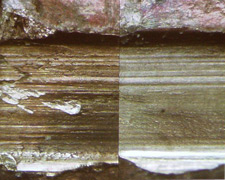Home | Glossary | Resources | Help | Contact Us | Course Map
Archival Notice
This is an archive page that is no longer being updated. It may contain outdated information and links may no longer function as originally intended.
Tool Actions
Striated or impressed marks may be produced by tools based on the types of actions performed. Tools may leave a variety of combinations of striated and impressed toolmarks as described in the following table.
| Tool Actions | ||
| Action | Description | Example |
| Scraping | A flat-bladed tool held at 90 to a surface and drawn across that surface | Door or window frame with surface scrapes from a screwdriver or pry bar |
| Pinching | An opposed blade cutting tool, such as a pair of bolt cutters or diagonal wire cutters | Remains of explosive devices |
| Shearing | Shear cutters, the blades of which are offset to pass by each other in the cutting process, such as tin snips or scissors | Cut alarm or telephone wires |
| Slicing | A single-bladed tool, such as a knife or axe | Tires, wires, and (rarely) bone and cartilage |
| Prying | A prying tool using leverage to force open a locked door or cover at one of its edges. May be a flat-bladed prying tool, (e.g., crowbar, screwdriver, tire iron, etc.) | Bank or store safe, or the strike plate of doors |
| Gripping | A gripping tool with opposing jaws, such as a pipe wrench, pliers, or a vise. Serrated jawed gripping tools add another dimension to the types of marks present. | Doorknobs |
| Crimping | An opposing jawed tool designed to press material together without cutting it | Lead seals (e.g., bank money bags, or containers for classified material) |
Physical Characteristics
The striated and impressed toolmarks may contain several levels of marks resulting from tool use on softer objects, including these:
- Class characteristics measurable features of a tool that indicate a limited group source. They result from design factors and are therefore determined prior to manufacture. Common examples would be the width of the tip of a screwdriver, the width of the jaw of a gripping tool, or the kind of cutting action employed by a tool.
- Individual characteristics marks on an object produced by the random imperfections or irregularities on the surfaces of the tools used to manufacture the object. These marks are produced incidental to the manufacturing process and are typically at the microscopic level. Individual characteristics can also be produced on an object by use, abuse, and the effects of random corrosion. To use the example of a screwdriver, individual characteristics could be found on the tip of a precision screwdriver by the process of finishing it using a grinding wheel. As a screwdriver is used, misused, and corrodes, it becomes more unique.
Note: Accidental characteristics is a term formerly used to mean individual characteristics. - Subclass characteristics discernable surface features of an object that are more restrictive than class characteristics, but not as unique as individual characteristics. In the screwdriver example, subclass or family characteristics might be found on the tip of a few hundred inexpensive screwdrivers stamped out by a dedicated machine, with no further finishing. The class characteristics of this stamping machine would gradually change, but not before producing a potentially large number of screwdrivers with tips bearing similar subclass characteristics.
Subclass characteristics are- produced incidental to the manufacture of a tool,
- significant because they relate to a smaller group source, that is, a subset of the class to which they belong,
- identifiable within a time frame since manufacturing processes change over time.
Subclass characteristics may be a pitfall in the examination and comparison of toolmarks simply because they can appear to be individual characteristics. Examination of the evidence tool allows the examiner to assess the level of subclass characteristics.
Additional Online Courses
- What Every First Responding Officer Should Know About DNA Evidence
- Collecting DNA Evidence at Property Crime Scenes
- DNA – A Prosecutor’s Practice Notebook
- Crime Scene and DNA Basics
- Laboratory Safety Programs
- DNA Amplification
- Population Genetics and Statistics
- Non-STR DNA Markers: SNPs, Y-STRs, LCN and mtDNA
- Firearms Examiner Training
- Forensic DNA Education for Law Enforcement Decisionmakers
- What Every Investigator and Evidence Technician Should Know About DNA Evidence
- Principles of Forensic DNA for Officers of the Court
- Law 101: Legal Guide for the Forensic Expert
- Laboratory Orientation and Testing of Body Fluids and Tissues
- DNA Extraction and Quantitation
- STR Data Analysis and Interpretation
- Communication Skills, Report Writing, and Courtroom Testimony
- Español for Law Enforcement
- Amplified DNA Product Separation for Forensic Analysts


